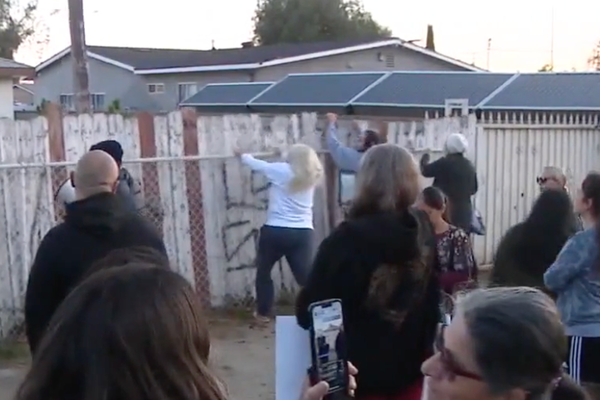
Rosamund Adoo-Kissi-Debrah reserves a withering eye roll for people who question the impact that air pollution has on the health of children living in London. It helps her to shrug off the increasingly politicised debate over what needs to be done to improve the capital’s air quality.
Adoo-Kissi-Debrah fought a calm and determined campaign for seven years to make sure air pollution was included on her daughter Ella’s death certificate, and in December 2020 a second inquest ruled that air pollution contributed to Ella’s death from asthma in 2013.
It was a landmark moment, the first time air pollution had been cited as a factor on a death certificate. But recently, as the row about London’s ultra-low emission zone (Ulez) expansion has intensified, some anti-Ulez campaigners have wilfully inverted the unprecedented finding and attempted to minimise the problem, declaring that only one person has died in the UK of air pollution-related causes since 2001.
On GB News earlier this year, Jacob Rees-Mogg questioned the estimate of about 4,000 pollution-related excess deaths regularly cited by the London mayor, Sadiq Khan.
“Our team actually checked the Office for National Statistics figure on deaths caused by pollution between the years 2001 and 2021. One death has been caused by car emissions in London. So there’s a vast disparity here between what Mr Khan claims and what is suggested by the ONS,” he said
A freedom of information response from the ONS, frequently shared by air pollution sceptics on Facebook and Twitter, states: “One death in England and Wales in the period 2001 to 2021 had exposure to air pollution … recorded on the death certificate.”
The conclusion drawn by those sharing the information is that if only one death has been recorded then the threat from air pollution must have been overstated.
A schoolteacher who has given classes in statistics, Adoo-Kissi-Debrah is particularly vexed by the misuse of the figure.
“Politics has got hold and it’s been turned on its head in a bizarre way. People say this to me all the time, trying to tell me that pollution is not a problem, that only one person has died from it. I try not to respond. When people feel they can’t win the argument, they resort to these tactics,” she said.
Rees-Mogg “is playing politics with this. He is manipulating the public. He’s an intelligent man and knows exactly what he’s doing,” she added. “I’m tired. This makes my job of raising awareness more difficult.”
The ONS response also makes clear that epidemiological studies estimating numbers of deaths that can be attributed to poor air quality may be more informative, and notes that it is “unusual for wider contextual factors such as exposure to car emissions, pollution or air quality to be recorded among the causes of death”. But neither Rees-Mogg nor online sceptics quote this part of the response.

There is a growing body of scientific evidence indicating that excessive exposure to air pollution raises the risk of cancer, dementia, strokes and heart attacks as well as respiratory illnesses. A comprehensive global review in 2019 concluded that air pollution may be damaging every organ in the body.
Air pollution has been linked to almost a million stillbirths a year. Official government estimates say between 28,000 and 36,000 deaths in the UK annually are caused by long-term exposure to humanmade air pollution.
Yet no one else has had the words “air pollution” put on their death certificate, and the lack of other individuals for whom it can be incontrovertibly stated that their health has been damaged by poor air quality makes this a largely invisible problem.
As the fight over the London’s clean air zones becomes more intense, the absence of other cases has created some problems for scientists and campaigners. Why does Ella’s death remain the only time a coroner has highlighted the role of air pollution on a death certificate?
From a distance, the lone instance seems puzzling and open to malicious distortion, but those close to the case know the complexities involved in proving the role played by air pollution.
Callout
Prof Frank Kelly, the chair in community health and policy at Imperial College London’s Global Centre of Air Pollution Research, said the medical system was “failing us by not recognising that air quality is a contributing factor” to the earlier deaths of thousands of people a year.
He acknowledged that it was unlikely that the inquest’s recognition that Ella’s death was linked to air pollution would swiftly open the way for other deaths to be similarly classified.
“I don’t see it happening again in the near future,” he said. The unprecedented scientific investigation mounted by Prof Sir Stephen Holgate, one of the UK’s leading experts on air pollution, and Rosamund Adoo-Kissi-Debrah was so exceptional that it would be unrealistic to expect more cases to follow.
In Ella’s case, Holgate was able to link 27 of her asthma-related hospitalisations with precise information about air pollution levels in the exact area where she lived, 25 metres from London’s congested South Circular.
Holgate himself is not optimistic that Ella’s inquest will open the way for air pollution to be highlighted on other people’s death certificates.
“This is exactly what we should be trying to do now, and have failed as a health community – to be able to pin down other cases,” he said.
He set out why her case was so unusual. “She was perfectly well; she went from a normal child, to a child aged nine who died from a disease that is entirely treatable. This was the most severe case of asthma I’ve ever seen in my life, and I’ve spent 45 years researching the causes of asthma; this was by no means routine asthma.”
Crucially, there was sophisticated air quality monitoring close to where she was living.
“It was fortuitous that she lived a mile away from a monitored site. For most people in the country, that isn’t the case because air quality is monitored by about 500 monitored sites, so there are two or three maybe in each city,” he said.
There was also a second set of pollution data that Holgate could draw on because the local council was planning to change the local bus fleet and was monitoring nitrogen dioxide (NO2) pollution levels.

“We had two pieces of air quality information that most people living in this country would never have access to because we don’t monitor pollution at such a local level,” he said
It took Holgate two and a half years to cross-reference that data with the hospitalisations as he endeavoured to demonstrate the role played by air pollution. Alongside this were samples that Adoo-Kissi-Debrah had asked to be taken from her daughter after she died, which were analysed before the second inquest.
For this process to be replicated, similar determination would be needed from more relatives, lawyers and scientists, as well as more routine air quality monitoring.
The legal process is expensive: while families are eligible for legal aid if they want, for example, a death in police custody to be examined at an inquest, there is no legal aid for assessing the role air pollution might have played. Coroners are given no training or guidance on including air pollution as a possible secondary cause of death.
“Parents who have children with severe asthma might wish to know whether air pollution is a contributory factor, but the only way of finding out is to have monitoring of pollution in and around the neighbourhood where the person is living and also of their personal exposure – which requires them to carry a monitor, such that their exposure as they move from one environment to another can be monitored across a period of time,” Holgate said. Local monitors cost between £3,000 and £9,000. “It’s not something councils are spending on. That’s why others haven’t raised the alarm.”
Kelly said that although it would be desirable for coroners to pay more attention to the contributory role air pollution plays in some deaths, a greater priority was for doctors and healthcare professionals to start making the link.
“In order to put air pollution on the certificate, they would need to understand the nature of the exposure that individuals have been experiencing over a number of years. If they were in high pollution areas, and their hospitalisation records coincided with increased air pollution, that would obviously require investigation,” he said.
“But we’ve got much bigger issues that are closer to the heart of the matter. We still don’t really have training in the medical curriculum for doctors and nurses and health practitioners about the link between air pollution and health. That’s something that’s really possible to do, but we need the royal colleges to agree to those changes in the training.”
Tim Dexter, the policy lead at the Asthma + Lung charity, said that while Ella’s death had raised awareness, medical professionals were still not discussing the possible impact of air quality.
“If you were to go to a GP and talk about the breathlessness that you are facing, it’s still not necessarily the first thing that’s raised. They’re still not asking: where do you live, what’s your immediate environment like, are you running or walking near a busy road? These are the questions that really need to be asked.”

Adoo-Kissi-Debrah has not enjoyed seeing her daughter’s death dragged into the political row over Ulez.
“If you’d told me three years ago that this issue would be at the centre of the mayoral campaign, I wouldn’t have believed you,” she said.
She was dismayed when she heard the Conservative MP Iain Duncan Smith comment that he was “happy” for his constituents to cement up Ulez cameras or put plastic bags over them. (“I’m glad I wasn’t giving assembly that day, what would I have told my students? Now because you disagree with something you can go and vandalise things?” Adoo-Kissi-Debrah said).
She still lives in the same house near the South Circular and worries about the impact of air pollution on her 16-year-old son, who also suffers from asthma. On her phone she shows pictures of him and his twin sister walking along the road during lockdown when it was empty. “I told them: enjoy it, this will never happen in your lifetime again.”
His asthma stabilised during lockdown but became severe after it lifted, which seems to echo a capital-wide trend for asthma problems receding during lockdown. (There were 11 deaths of children from asthma in London in 2018; in 2020 and 2021, the years in which a national lockdown was enforced, there were two asthma deaths recorded in London.)
She is not especially hoping to see more cases of air pollution listed on death certificates (“That would mean more people dying,” she points out) but she does want GPs to start flagging the dangers of air pollution with patients, and she would like to see more air pollution monitors installed.
She continues to push for an Ella’s law to be adopted, which would force the government to adopt a target to cut PM2.5 particulate pollution to 10 micrograms per cubic metre by 2030, 10 years sooner than its current commitment.
“The coroner’s line to the government was that unless the air is clean, more children like Ella are going to die. So I don’t understand why they’ve moved the particulate matter target to 2040. That’s a whole generation away,” she said.
She remains unhappy at the government’s response to Ella’s death. “People need to remember how much my daughter suffered. We’re still waiting for an apology.”







